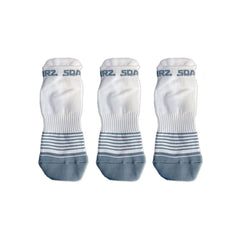Having the best gear makes you play better… right?
That’s what we’ve all been taught. And to a point, it’s true. Golfers obsess over their swing, then start tweaking everything else—clubs, balls, gloves, tees, shafts, launch angle, spin rates. The list goes on. But in all that tweaking, there’s one performance tool most golfers completely overlook: footwear.
Footwear is one of the most critical—yet underappreciated—factors in your golf swing, and the data is finally showing why it’s time to take it seriously.
But let’s back up.
There’s a certain stage of golf obsession that hits like a fever. One minute you're buying your first set of clubs. The next? You’re up at 2am watching YouTube reviews about 2023 driver head aerodynamics and arguing on forums about spin axis tilt.
Your garage starts to look less like a place to park a car and more like a failed attempt at opening a secondhand golf pro shop. Drivers. Hybrids. That one $600 putter you swore would "finally fix your stroke." You've got golf balls that promise to go farther, spin less, spin more, stop quicker, fly straighter—and somehow all of them are still finding the woods.
Every January, club companies roll out their shiny new releases with phrases like "revolutionary carbon composite shaft", "redesigned aerodynamic head", or "optimized launch window for increased carry." Ball companies jump in with claims of "next-generation ionomer casing layers" or "tour-level distance with soft feel and piercing trajectory."
It's exhausting. It’s expensive. And it’s hilarious when you think about it—because if every promise you’ve been sold actually delivered, you’d be out-driving Bryson by now. You should be carrying it 1000 yards with a 3-wood and landing it soft on a dime. But reality? You’re still duck-hooking your opening tee shot, blaming the wind, and muttering something about “needing to upgrade the shaft.”
But here’s the thing—despite all the supposed innovation, the reality for most golfers tells a very different story. In fact, recent data shows that the average male amateur driving distance has actually gone down in the past few years.
Yes—down.
So what gives? With all this high-tech equipment promising longer drives, why are distances trending in the opposite direction?
Well, one shift might explain more than you think. Because the average driving distance dropped... something else quietly rose: the popularity of spikeless golf shoes.
And that’s where things start to get interesting.
Tech Everywhere… But Distance Is Flatlining

In case you missed it, MyGolfSpy covered a study from Arccos that analyzed over 1 billion tracked drives across everyday golfers. The findings? Despite the explosion in golf tech, driving distances have decreased.
In 2018, the average male drive was 226.4 yards. Four years later in 2023, the average male drive was 225.0 yards. That's a decrease of 1.4 yards.
Here’s why:
There’s a growing trend in footwear that almost every sport is chasing—what we call the “sneakerization” of performance shoes. Everyone wants lighter, sleeker, sneaker-like shoes that feel good walking from the parking lot to the first tee. But here's the catch: that lightweight comfort often comes at the cost of traction, stability, and ground force.
And the data backs it up. In 2022, 63% of the golf footwear market was spikeless. That means the majority of recreational golfers are playing in shoes that prioritize comfort over performance.

Side note: 82% of Tour players wear spikes (by the way—their average driving distance has increased by 4 yards since 2018.
So if your drives are shorter today than they were five years ago, the issue may not be your club, your swing, or even your ball—it might just be your shoes.
All That Tech, and You’re Still Hitting It the Same Distance
Golf is one of the most tightly regulated sports on the planet when it comes to gear. Nearly everything you swing or strike is policed by a thick stack of USGA rules—all in the name of keeping the game fair and preserving the integrity.
-
Clubs? There are strict limits on head size, face flex (CT), shaft length, and groove design.
-
Balls? Speed, size, and distance are all capped through conformance tests.
Basically, once a piece of gear hits the legal ceiling, all that’s left is fine-tuning—and we’re talking about microscopic gains. A few extra RPMs here. Maybe half a yard there.
That’s why every new product launch feels eerily familiar: “This one’s longer!” “Faster face!” “Optimized trajectory!” But when the dust settles and you check your Arccos stats or watch your tee shot trickle off the fairway... you're still right where you were last season.
But there’s one piece of golf equipment that can actually help: your shoes.
Footwear is the last piece of golf equipment that’s 100% in your control—and it’s one of the few areas where real, measurable improvement is still on the table. Most golfers are chasing distance in the tiniest margins, looking for magic in gear that’s already maxed out. But the right shoes? They can unlock more balance, more power, and yes—more distance—than any new driver ever could.
The Connection Everyone Ignores (And Shouldn’t)
Let’s take a step back and think about the two physical connections in golf:
-
Your hands to the club
-
Your feet to the ground
That second one? It’s often treated as an afterthought—yet it’s the foundation of every swing.
You’ve heard the classic tips:
“Square your shoulders.”
“Place your hands like this.”
“Pretend there’s a towel under your arms.”
“Make sure your feet are aligned.”
Cool. But here’s the question no one’s asking:
How are you supposed to generate real power, stay balanced, and create ground force… if your base is unstable?
That’s the problem.
Spikeless shoes? They might be comfortable, but they don’t give you the structure or traction you need to stay grounded through your swing. Most traditional spiked shoes? Still not built with real ground connection in mind. They’re stiff in the wrong places and cramped where they shouldn’t be.
And yet we all care. About performance. About getting better. About shooting lower scores.
So why would you leave strokes on the course—and be less comfortable doing it—because of your shoes?
Side Challenge:
Try this real quick. You’re probably sitting down right now—so stay in your chair, pick your feet off the ground, and take a practice swing. Go ahead, really go for it.
Now imagine where that ball would’ve gone. Spoiler: it probably wouldn’t even leave the room.
That’s because ground force—your connection to the turf—is one of the biggest drivers of distance in your swing. No stable base, no power. It’s that simple.
And yet most golfers are still sleeping on the one piece of gear that actually helps you harness it.
We Didn’t Change the Swing—We Changed the Shoes
This is the exact problem SQAIRZ set out to solve. We reengineered golf footwear to make ground connection a performance asset.
In a Golf Labs study, players wearing SQAIRZ gained an average of +2.92 MPH swing speed and +8.8 yards in distance, just by changing their shoes. No swing tweak. No new club. Just smarter design.
It starts with the geometry of our patented roomier toe box, which lets your toes naturally spread out and grip the ground—creating a stable, powerful base. Traditional golf shoes restrict this connection, weakening your foundation before you’ve even started your backswing.
Then we built around it: Smart Traction™ outsole for superior grip and ground feel, NRG™ Foam midsoles for explosive energy return, and dual-density insoles for structured comfort that lasts 18 holes and beyond.
Now, we’ve taken that same performance-driven approach and applied it to a lighter design.
This year’s new LT series keeps everything that makes SQAIRZ different—and cuts the weight. It’s over 3 ounces lighter than leading spiked shoes in the same category, making it the lightest performance golf shoe you can find.
That reduction in weight matters, especially over 18 holes. And when paired with the same stability and ground connection SQAIRZ is known for, it offers a combination that’s hard to find in today’s footwear: lightweight feel with performance that actually holds up under pressure—and distance gains that come from using the ground better.
Before You Upgrade Again, Look Down
So this season, before you reach for another new driver, or drop $50 on a box of balls that promise to “cut through the wind,” take a beat. Look down. Your connection to the ground might be the only part of your game that hasn't been over-engineered, overhyped, or regulated into oblivion. Instead of cramming more gear into the garage or spending another weekend learning acronyms like MOI, CG, and AOA, you could make one simple change that actually delivers. Because when your shoes help you swing faster, stay grounded, and walk the course in total comfort—you’re not just investing in equipment. You’re finally investing in performance that holds up.
This season, let your feet do what your driver can’t.





